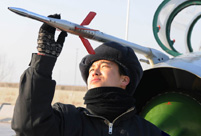 Int'l Snow Sculpture Art Expo in Harbin
Int'l Snow Sculpture Art Expo in Harbin Sichuan money wall for dividend payment
Sichuan money wall for dividend payment Li Na crashes Belinda Bencic in 2nd round at Australian Open
Li Na crashes Belinda Bencic in 2nd round at Australian Open
 Shocking moments when PLA's weapons open fire
Shocking moments when PLA's weapons open fire Famous Lanzhou beef noodles
Famous Lanzhou beef noodles Armed Police hold anti-terrorism drill in SE China's Xiamen
Armed Police hold anti-terrorism drill in SE China's Xiamen Harbin Int'l Ice and Snow Festival opens
Harbin Int'l Ice and Snow Festival opens 'Jin' named the word of the year by cross-strait netizens
'Jin' named the word of the year by cross-strait netizens Chinese scientific expedition goes to build new Antarctica station
Chinese scientific expedition goes to build new Antarctica station
BEIJING, Jan. 22 (Xinhua) -- People living in south China have been grumbling about gales blowing smog in from the north, as hazardous air chokes more parts of the country this winter.
In 2013, China's smog belt stretched from the developed regions of the Yangtze and Zhujiang river deltas and areas around Beijing and Tianjin, to other places where smog was seldom seen. The southernmost province of Hainan and autonomous region of Tibet recorded smoggy days.
Chinese Academy of Sciences issued a report last month about climate change, saying that besides local pollutants, "smog migration" was another serious problem.
In Beijing, 30 percent to 40 percent of the PM 2.5, airborne particles smaller than 2.5 microns in diameter, was caused by emissions, 20 percent to 30 percent from chemical conversion in the atmosphere, and the rest from smog movement, according to the report.
Meanwhile, according to statistics published monthly by the Ministry of Environmental Protection, Hebei Province, around Beijing, is home to up to seven of the country's top 10 polluted cities.
Chen Changsheng, deputy director of the meteorological center of Jilin Province, said the idea of "smog migration" originates from "advection fog" that usually appears in winter and moves with wind for a long period of time.
He explained that when advection fog emerges, local air particles like dust and secondary inorganic aerosols -- sulfates and nitrates -- will mingle with the mist from other places, and generate smog, which means it is hard to correctly attribute the causes.
"The wind field in middle latitude makes smog movement possible from north China to south in winter," said Zhao Chuanfeng, a professor with the College of Global Change and Earth System Science of Beijing Normal University.
He said that big particles like dust can drop to land in one or two days, but tiny ones always float in the air for much longer, moving with wind which forms smog migration.
Chen Nan, senior engineer with the monitoring center of Hubei Province, agreed with the possibility of distant smog migration, but he said that intricate pollution discharge and weather conditions in winter sometimes prevent the spreading of smog.
Zhao also said that local influences are more obvious in generating smog, which needs concrete analysis before any assertion that smog migrates from north to south.
However, no matter to what extent smog migration contributes to air pollution, the problem has been awful enough for China to take action.
A popular Chinese joke "Christmas has to be canceled because Santa Claus got lost and fell in the snow" mocked the poor air quality on Christmas Eve, when smog readings of 16 monitored cities, exceeded 300, about six times the safe level.
Serious air pollution plagues most major Chinese cities, where environmental protection has been sacrificed for the sake of economic development.
To tackle the worsening air quality, Zhao suggested cloud seeding for heavy rainfall to wash out aerosol in the air, to prevent pollutants gathering into smog.
Lu Lunyan, China's climate and energy project manager of the World Wildlife Fund, said that the country needs a "revolution" in renewable energy sources to tackle air pollution.
She stressed that the country must adopt effective policies to decrease demands for natural resources and increase support for pollution solutions.
China has beefed up regulations and pledged financial resources to fight pollution.
A five-year action plan was unveiled by the central government in September to cut coal use, shut down polluters, promote cleaner production and lower the density of inhalable particulate matter. Putting the ambitious ideas in practice will cost an estimated 1.75 trillion yuan (286.48 billion U.S. dollars).
 Su-30 fighter formation taking off for training
Su-30 fighter formation taking off for training  Xuelong carries on mission after breaking from floes
Xuelong carries on mission after breaking from floes Charity exhibition raises money for panda protection
Charity exhibition raises money for panda protection 'Map of China' on the stone
'Map of China' on the stone  Chinese naval escort taskforce repels 4 suspicious vessels
Chinese naval escort taskforce repels 4 suspicious vessels World's weekly photos (1.6-1.12)
World's weekly photos (1.6-1.12) Li Na crashes Belinda Bencic in 2nd round at Australian Open
Li Na crashes Belinda Bencic in 2nd round at Australian Open Weekly sports photos
Weekly sports photos China's national pole dancing to play 'The Butterfly Love'
China's national pole dancing to play 'The Butterfly Love'  The never-ending Silk Road
The never-ending Silk Road  Spring Festival travel rush: One window, one world
Spring Festival travel rush: One window, one world Int'l Snow Sculpture Art Expo in Harbin
Int'l Snow Sculpture Art Expo in Harbin China photographs internal structure of water molecule
China photographs internal structure of water molecule 'Predator' makes proposal to girlfriend
'Predator' makes proposal to girlfriend Thousands of fish frozen on Norway sea
Thousands of fish frozen on Norway seaDay|Week|Month